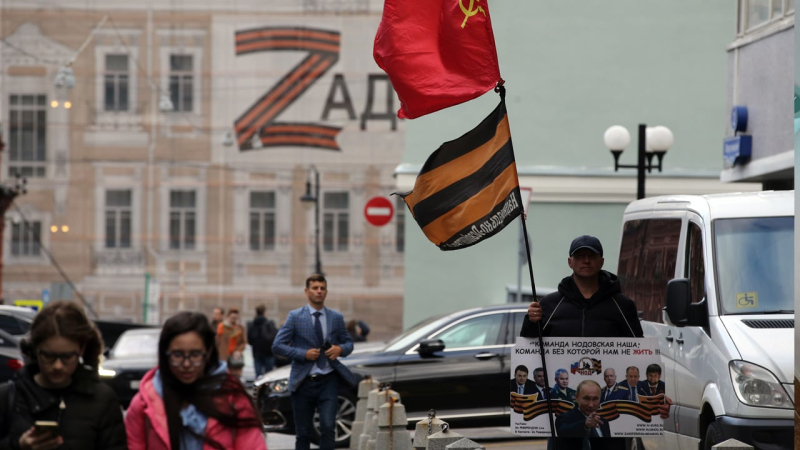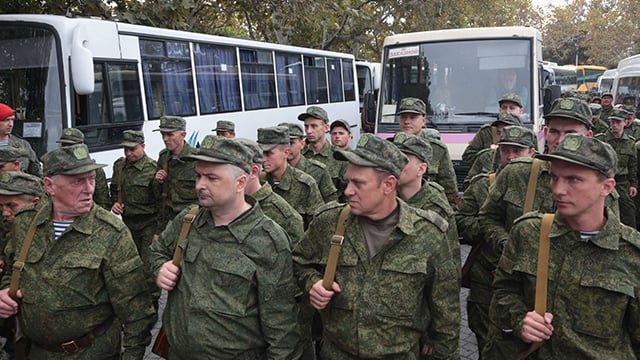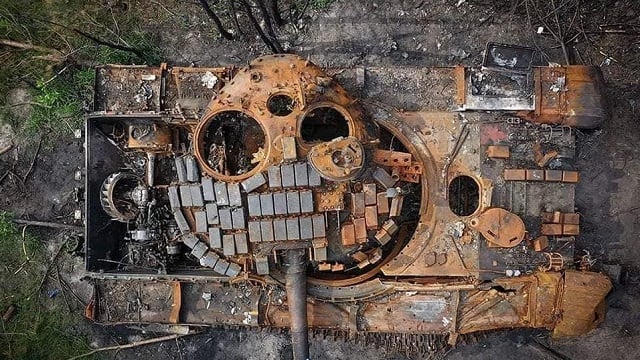
The Russian Armed Forces will likely reach their peak strength at the end of 2024, and material problems will increase throughout 2025.
This is stated in the analytical note by Jack Watling and Nick Reynolds, who are research fellows Royal United Studies Institute (RUSI).< /p>
As analysts point out, it is important to understand exactly what Russia was trying to achieve by invading Ukraine in February 2022, as well as how the Kremlin intends to achieve its goals and what its capabilities are to implement this plan. < /p>Currently watching
The material states that the Russian theory of what constitutes victory for them changed several times during the war.
— But now Moscow has a clear plan for how it intends to act, — analysts write and propose to consider the basis of Russian planning, as well as how these plans can be thwarted.
Strategic goals of Russia
Analysts indicate that Russia continues to pursue the strategic goal of subjugating Ukraine.
— The terms of surrender currently proposed by Russian mediators include Ukraine handing over territory already under Russian control, as well as Kharkov and, according to some versions, Odessa; agreement not to join NATO; and the preservation of the head of state approved by Russia. The only significant concession Russia is offering is that the remaining Ukraine can join the EU, — experts say.
The process by which Russia intends to achieve such a result consists of three stages:
- The first requires continued pressure along the entire length of the Ukrainian front in order to deplete the ammunition and personnel reserves of the Ukrainian Armed Forces.
- In parallel with this, Russian intelligence services are tasked with breaking the resolve of Ukraine’s international partners to continue providing military assistance.
- Once military assistance is significantly limited and Ukrainian ammunition stocks are depleted, Russia intends to launch further offensive operations to achieve significant — albeit slow — success on the battlefield.
— These successes are then supposed to be used as leverage on Kyiv to force it to capitulate on Russian terms, — researchers write.
The planning horizon for the implementation of these goals assumes that victory should be achieved by 2026.
— It is important to understand that Russia's goals can expand as it succeeds, and given that the Kremlin has violated almost every major agreement with both Ukraine and NATO, there is no guarantee that even if Russia gets what it wants from the negotiations, it will not will subsequently attempt to physically occupy the rest of Ukraine or will not be disposed to use force elsewhere, — analysts say.
Military potential of Russia
According to RUSI experts, by the beginning of 2024, the Russian operational group of troops in the occupied territories of Ukraine consisted of 470 thousand military personnel.
— While the quality of Russian forces is unlikely to improve as long as the Ukrainians can maintain a significant level of personnel casualties, the Russians will be able to maintain a steady pace of attacks through 2024, — writes the publication.
RUSI indicates that the Russian group of troops continues to suffer significant losses, but, nevertheless, is growing in number.

Photo: Getty Images
Large operations allow the Russian military to take measures to guarantee the integrity of the front line. Units can generally be withdrawn from the front line after they have suffered up to 30% casualties — this is the point after which they are considered ineffective, — and then restored, experts write.
— Although there are no large-scale offensives currently underway, Russian units are tasked with conducting small tactical attacks that, at a minimum, inflict sustained casualties on Ukraine and allow Russian forces to capture and hold positions. Thus, the Russians maintain constant pressure on a number of points, — analysts write.
At the same time, the desire of the Russian military to increase the number of its forces to 1.5 million people was not realized, and currently recruiters are fulfilling almost 85% of the assigned tasks for recruiting military personnel for the war against Ukraine. It is for this reason, observers say, that the Kremlin thinks it can maintain the current rate of decline until 2025.
Military equipment of the Russian Federation
As for military equipment, the Russian troops are in service with:
- about 4780 cannon artillery pieces, of which 20% — self-propelled;
- 1130 MLRS;
- 2060 tanks
- and 7,080 other armored fighting vehicles, mainly consisting of MT-LB, infantry fighting vehicles and armored personnel carriers.
In addition, aircraft regularly support equipment on the ground. RUSI experts write that we are talking about:
- 290 helicopters (110 of which — combat)
- and 310 jet aircraft.
— The use of these equipment sets is limited by shortages of ammunition, especially for such key systems as 220-mm multiple rocket launchers (MLRS), and the unstable availability of 152-mm ammunition.
Some complexes, such as high-speed aviation, are limited by the availability of pilots with sufficient experience to fly key missions, since Russian crew losses amount to 159 people, which, given the unevenness of flight hours in Russian squadrons, is a serious loss of capacity.
However, the Russian Aerospace Forces (VKS) can continue to fly a significant number of sorties and deliver munitions for the standoff.
— The general assessment is that while the quality of Russian forces is unlikely to improve, as long as the Ukrainian Armed Forces are able to maintain significant levels of attrition, the Russians will be able to maintain a steady pace of attacks through 2024, — experts write.
Industrial potential of Russia
According to RUSI experts, the potential of Russian industry to support current operations has been significantly mobilized in the defense industry.
The number of jobs was increased and production lines were expanded at existing plants. Mothballed factories were also put into operation.
— This led to a significant increase in production volumes, — counted in RUSI.
According to experts, Russia supplies the troops with about 1.5 thousand tanks per year, as well as about 3 thousand armored combat vehicles of various types. Russian missile production has similarly increased.
Despite these achievements, Russia faces significant limitations in the durability and reliability of its industrial products.
— For example, of tanks and other armored fighting vehicles, about 80% are not new products, but restored and modernized from Russian military stocks. The number of systems in storage means that while Russia can maintain constant production until 2024, by 2025 it will begin to find machines requiring deeper upgrades, and by 2026 it will have exhausted most of its existing stock, &# 8212; experts write.

Photo: ZSU General Staff
So, as the number of repaired vehicles decreases, industrial capacity can be directed to the production of new platforms, but this will inevitably lead to a significant reduction in the number of vehicles supplied to the Russian troops.
Another vulnerability of Russian high-tech weapons such as missiles is their heavy dependence on Western components. According to experts, today Russia still has access to the necessary components, despite the sanctions of Western countries, but a more consistent policy of the EU and US countries will lead to a likely disruption of supply chains.
— Even with the current flawed approach, the cost of components for the Russian defense sector has increased by 30%, and it has only managed to stabilize supplies rather than expand them, despite additional investment in this area, — RUSI analysts write.
At the same time, the most serious limitation for the Russian Federation is the production of ammunition.
RUSI points out that if Russia wants to implement its plans to seize Ukraine in 2025, then for this the need of Russian industry, according to estimates of the Russian Ministry of Defense, is approximately 4 million 152-mm and 1.6 million 122 -mm artillery shells in 2024.
However, the Russian industry, in response to a request from the Russian Ministry of Defense, reported that it expects to increase the production of 152-mm shells from approximately 1 million in 2023 to 1.3 million during 2024, and only 800 thousand 122-mm shells will be produced during the same period . things. Moreover, the Russian Ministry of Defense does not believe that it will be able to significantly increase production in the coming years unless new factories are created and funds are not invested in the extraction of raw materials with a delay of more than five years.
— This means that in order to provide the armed forces with resources, Russia must — in the short term — further reduce the remaining 3 million pieces of ammunition, although most of them are in poor condition. To compensate for the shortfall, Russia has signed supply and production contracts with Belarus, Iran, North Korea and Syria, with the latter only able to supply stamped casings, not whole projectiles, — experts say.
However, such supplies will not be able to compensate for the significant shortage of 152-mm ammunition in 2025.
RUSI estimates that overall Russian artillery production is likely to plateau at 3 million rounds per year of all types, including MLRS, which are not discussed above.
Conclusion
Researchers at the Royal United Nations Institute for Defense Studies believe that the Russian theory of victory is plausible, if Ukraine's international partners fail to properly resource the Ukrainian Armed Forces.
— However, if Ukraine's partners continue to provide the Ukrainian Armed Forces with sufficient ammunition and training support to ensure that Russian attacks are weakened in 2024, then Russia is unlikely to make significant progress in 2025, — says the material.
However, if Russia has no prospects for success in 2025, given its inability to improve the quality of forces for offensive operations, then it follows that Moscow will have a difficult time forcing Kiev to capitulate by 2026.
After 2026, the retirement of systems will begin to significantly reduce Russia's combat power, and Russian industry by this time may be sufficiently undermined, which will eventually lead to a decrease in Russia's prospects.
— The latter will require Ukraine's partners to demonstrate a semblance of competence in their efforts to counter Russian defense mobilization, which remains entirely possible despite their performance to date, — experts write.
In conclusion, RUSI analysts point out that adopting an approach in which Ukraine’s stability will be ensured until 2025 will not only undermine the Kremlin’s theory of victory, but will also provide enough time to create a rational process for mobilizing and preparing the Armed Forces of Ukraine.
— This is critical to creating opportunities to continue to threaten Russia's position and thereby force it not just to seek negotiations, but to actually negotiate an end to the war on terms favorable to Ukraine. Now is not the time to submit to the Kremlin's understanding of the war's trajectory, — experts summarize.
The day before, experts from the International Institute for Strategic Studies (IISS), in the journal Military balance, stated that during the full-scale war, Russia lost more than 3 thousand tanks in Ukraine, which is equivalent to its entire pre-war active arsenal. < /p>

